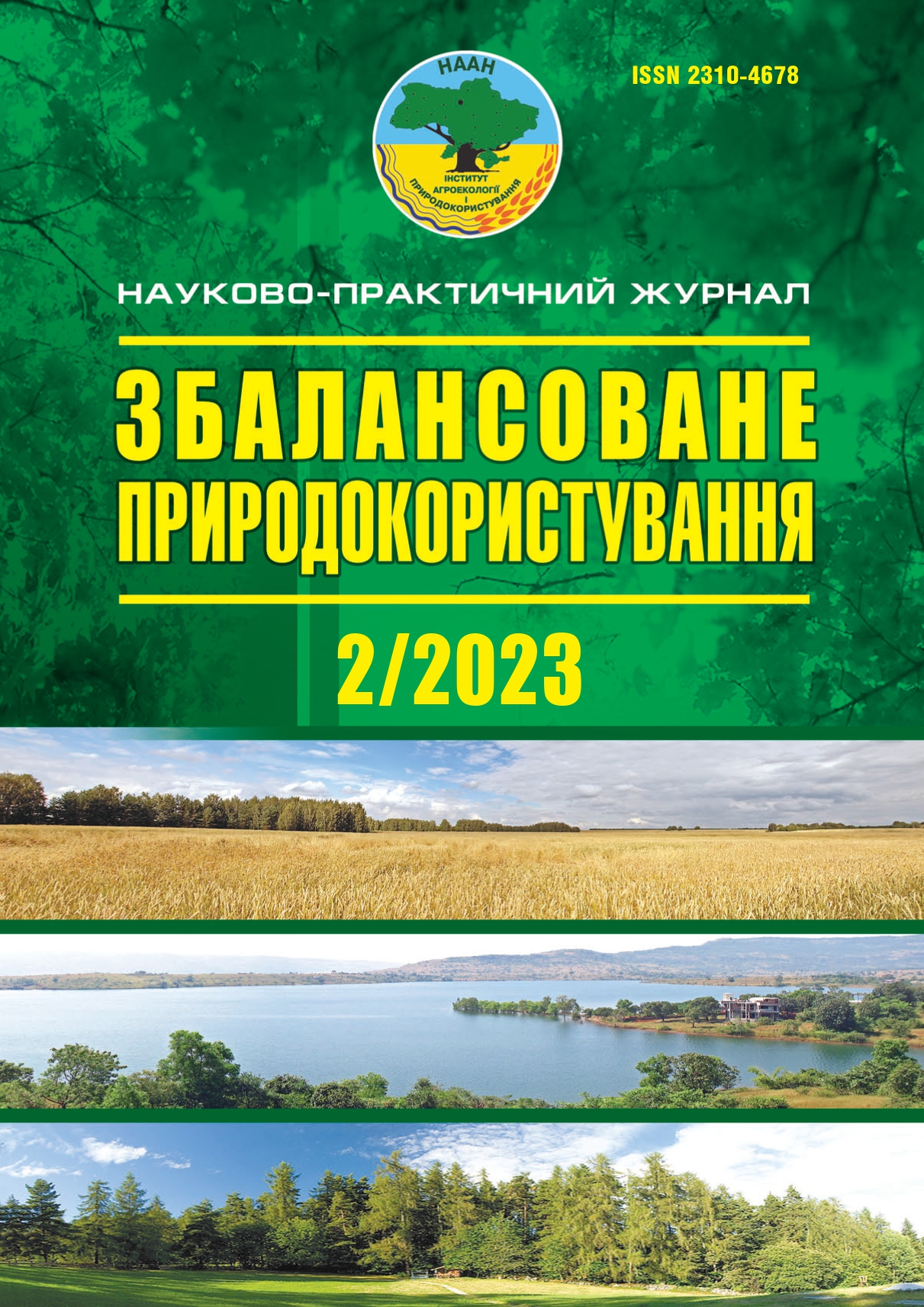Наукові основи природно-сільськогосподарського районування території України в сучасних умовах
DOI:
https://doi.org/10.33730/2310-4678.2.2023.282745Ключові слова:
забруднення, токсичні речовини, вірусні інфекції, ґрунтовий покривАнотація
У статті висвітлено теоретико-методологічні підходи щодо природно-сільськогосподарського районування території України в сучасних умовах для забезпечення екологічно збалансованого, економічно ефективного й соціально орієнтованого використання сільськогосподарських земель. Вони обумовлені масштабними викликами: глобальним потеплінням, яке потребує зміни й уточнення зональних меж на державному рівні (природно-сільськогосподарські зони, провінції і округи); агресивною російсько-українською війною, що спричиняє низку механічних, фізичних і хімічних негативних впливів на ґрунтовий покрив. Зокрема, де відбувалися і відбуваються бойові дії (Київська, Чернігівська, Сумська, Харківська, Луганська, Донецька, Запорізька, Херсонська, Миколаївська області); вірусне забруднення сільськогосподарських рослин і ґрунтів у результаті порушення сівозмін як важливого фітосанітарного засобу захисту рослин і ґрунту від вірусних інфекцій. Як стверджують вірусологи, техногенне навантаження на природне середовище вже сьогодні й у найближчому майбутньому буде швидше зростати, ніж зменшуватися, а в агроценози будуть приходити все нові й нові, в тому числі й генетично модифіковані, культурні рослини. Проблеми екологічного балансу в агроценозі будуть набувати все більшого значення, і питання розповсюдження фітовірусних інфекцій та їх шкодочинності в майбутньому може розглядатися як одне з найгостріших. Вказані виклики обумовлюють необхідність вносити суттєві зміни, особливо в межі, природно-сільськогосподарського районування території держави, а також і відповідні таксономічні одиниці (природно-сільськогосподарський район — як ареал території, в межах якого спостерігається вирівняна залежність рослинництва, головним чином землеробства, від кліматичних умов і ґрунтового покриву сільськогосподарських угідь, зокрема орних земель. Мікрорайонні відмінності цих факторів мають бути істотними). Ці зміни слід вносити на основі суцільного великомасштабного ґрунтового обстеження.
Посилання
Bulyhin, S.Yu. (2005). Formuvannia ekolohichno stalykh ahrolandshaftiv [Formation of ecologically sustainable agricultural landscapes]. K.: Urozhai [in Ukrainian].
Dobriak, D.S., Kanash, O.P., Babmindra, D.I., Rozumnyi, I.A. (2009). Klasyfikatsiia silskohospodarskykh zemel yak naukova peredumova yikh ekolohobezpechnoho vykorystannia. 2-he vyd., dopov. [Classification of agricultural lands as a scientific prerequisite for their ecologically safe use. 2nd ed., supplement]. K.: Urozhai [in Ukrainian].
Dobriak, D.S., Drebot, O.I., Melnyk, P.P. (2019). Naukovi osnovy vyznachennia zon vyroshchuvannia osnovnykh silskohospodarskykh kultur Ukrainy [Scientific basis for determining the zones of cultivation of the main agricultural crops of Ukraine]. Zbalansovane pryrodokorystuvannia — Balanced natue using, 3, 15–27 [in Ukrainian].
Didukh, Ya.P., Sheliah-Sosonko, Yu.R. (2003). Heobotanichne raionuvannia Ukrainy ta sumizhnykh terytorii [Geobotanical zoning of Ukraine and adjacent territories]. Ukrainskyi botanichnyi zhurnal — Ukrainian botanical journal, 60 (1), 6–17 [in Ukrainian].
Yehorova, T.M., Konishchuk, V.V. (2014). Aktualni pytannia ahroekolohichnoho raionuvannia Ukrainy [Actual issues of agro-ecological zoning of Ukraine]. Visnyk Dnipropetrovskoho derzhavnoho ahrarnoho universytetu — Bulletin of the Dnipropetrovsk State Agrarian University, 1, 156–161 [in Ukrainian].
Pro zatverdzhennia Poriadku zdiisnennia pryrodno-silskohospodarskoho, ekoloho-ekonomichnoho, protyeroziinoho ta inshykh vydiv raionuvannia zemel: Postanova Kabinetu Ministriv Ukrainy vid 26.05.2004 r. № 681 [On the approval of the Procedure for implementing natural-agricultural, ecological-economic, anti-erosion and other types of land zoning: Resolution of the Cabinet of Ministers of Ukraine dated 05/26/2004 No. 681]. (2004). URL: https://zakon.rada.gov.ua/laws/show/681-2004-%D0%BF#Text [in Ukrainian].
Furdychko, O.I. (Ed.), Konishchuk, V.V. Yehorova, T.M., Melnyk, N.B. (2014). Ahroekolohichne roztashuvannia (metodychni rekomendatsii) [Agroecological location (methodical recommendations)]. K.: DIA [in Ukrainian].
Novakovska, I.O. (2018). Ekonomika zemlekorystuvannia: navch. posib. [Economics of land use: educational guide]. K.: Ahrar. nauka [in Ukrainian].
Polishchuka, V.P. (Ed.), Budzanivska, I.H., Ryzhuk, S.M., Patyka, V.P., Boiko, A.L. (2001). Monitorynh virusnykh infektsii roslyn v biotsenozakh Ukrainy [Monitoring of plant viral infections in biocenoses of Ukraine]. Kyiv: “Fitosotsiotsentr” [in Ukrainian].
Furdychko, O.I. (2014). Ekolohichni osnovy zbalansovanoho rozvytku ahrosfery v konteksti yevropeiskoi intehratsii Ukrainy [Ecological foundations of the balanced development of the agricultural sector in the context of the European integration of Ukraine]. K.: DIA [in Ukrainian]
##submission.downloads##
Опубліковано
Номер
Розділ
Ліцензія
- Автори залишають за собою право на авторство своєї роботи та передають журналу право першої публікації цієї роботи на умовах ліцензії Creative Commons Attribution License, котра дозволяє іншим особам вільно розповсюджувати опубліковану роботу з обов'язковим посиланням на авторів оригінальної роботи та першу публікацію роботи у цьому журналі.
- Автори мають право укладати самостійні додаткові угоди щодо неексклюзивного розповсюдження роботи у тому вигляді, в якому вона була опублікована цим журналом (наприклад, розміщувати роботу в електронному сховищі установи або публікувати у складі монографії), за умови збереження посилання на першу публікацію роботи у цьому журналі.
- Політика журналу дозволяє і заохочує розміщення авторами в мережі Інтернет (наприклад, у сховищах установ або на особистих веб-сайтах) рукопису роботи, як до подання цього рукопису до редакції, так і під час його редакційного опрацювання, оскільки це сприяє виникненню продуктивної наукової дискусії та позитивно позначається на оперативності та динаміці цитування опублікованої роботи (див. The Effect of Open Access).


